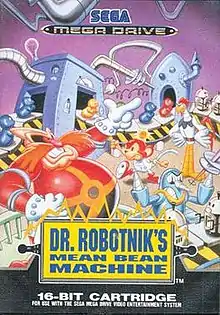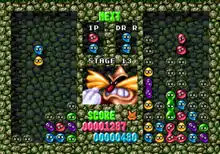Dr. Robotnik's Mean Bean Machine
Dr. Robotnik's Mean Bean Machine[lower-alpha 1] is a falling block puzzle game developed by Compile and published by Sega. It was released for the Mega Drive and in North America and Europe on November 1993, and ported to the Game Gear in 1993 and Master System in 1994.
| Dr. Robotnik's Mean Bean Machine | |
|---|---|
 UK cover art | |
| Developer(s) | Compile |
| Publisher(s) | Sega |
| Director(s) | Tetsuo Shinyu Takayuki Yanagihori Masanobu Tsukamoto |
| Producer(s) | Yoji Ishii Noriyoshi Oba Masamitsu Niitani Max Taylor |
| Programmer(s) | Manabu Ishihara Tsukasa Aoki |
| Composer(s) | Masanori Hikichi Masayuki Nagao |
| Series | Sonic the Hedgehog |
| Platform(s) | Mega Drive, Game Gear, Master System |
| Release | Sega GenesisGame GearMaster System
|
| Genre(s) | Falling block puzzle |
| Mode(s) | Single-player, multiplayer |
The game is a Westernised version of Puyo Puyo (1991), and replaces its characters with those from the Sonic the Hedgehog franchise, primarily the Adventures of Sonic the Hedgehog animated series. The character Puyo Puyo character Carbuncle still appears and makes different animations depending on how the player plays the game. The gameplay is similar to puzzle games such as Tetris, in which the player organises coloured shapes as they descend a board. The plot sees Sonic antagonist Doctor Robotnik kidnapping residents from Beanville and turning them into robots. The game received mostly positive reviews, with critics praising the gameplay but criticising the difficulty.
Plot
The game is set on the planet Mobius, which is inhabited by bean-like creatures. Doctor Robotnik conceives of a plan to bring terror to the world by kidnapping the citizens of Beanville and turning them into robot slaves, and eventually creating an army that will help him rid the planet of fun and joy. To achieve this, he creates the "Mean Bean-Steaming Machine" in order to transform the bean-like creatures into robots. Putting his plan into motion, Robotnik sends out his Henchbots to gather all the bean-like creatures and group them together in dark dungeons so they can be sent to the Mean Bean-Steaming Machine.[1] The rest of the game's story revolves around the player character, "Has Bean",[2] and their journey to stop Robotnik's henchmen by breaking into the dungeons and freeing the bean-like creatures.
Gameplay

Dr. Robotnik's Mean Bean Machine is based on Puyo Puyo, a Japanese falling-block puzzle game. In the story, players must rescue Beanville from Dr. Robotnik and his army of Badniks. In Scenario Mode, the player plays against 13 increasingly challenging computer opponents. In the multiplayer 1P vs 2P Mode, two players battle against each other, and in Exercise Mode, players can simply practise.[3][2] The Game Gear and Master System versions feature an additional mode, Puzzle Mode, in which players must attempt to clear predetermined sets of beans.
On each player's grid, groups of beans fall from the top of the screen and can be moved and rotated until they reach the bottom. When four beans of the same colour are matched together, they disappear from the grid, causing any beans above to drop.[4][5][6] These beans can trigger other matches, resulting in chain combos.[6] By performing chain combos, players can send grey "refugee beans" to hinder their opponent. These beans cannot be matched normally and can only be removed by completing a match adjacent to them.[7] A player loses when beans spill over the top of the board, leaving them unable to add more.[8]
Development and release
Dr. Robotnik's Mean Bean Machine is a Westernised version of Puyo Puyo (1991), a Japanese falling-block puzzle game developed by Compile and released for the MSX2 in 1991.[9][10] Fearing that the game would not be popular with the Western audience, Sega replaced the characters of Puyo Puyo with those from the Sonic the Hedgehog franchise, particularly those from the 1993 Adventures of Sonic the Hedgehog animated series.[11] The game was ultimately released in November 1993 in North America and Europe. An 8-bit version was also released for the Game Gear in the same year and the Master System in the following year, adapted from the Japanese Nazo Puyo game.[12][13]
Dr. Robotnik's Mean Bean Machine has also appeared in retrospective compilations, such as the Sonic Mega Collection for the GameCube in 2002,[14] Sonic Mega Collection Plus for the PlayStation 2 and Xbox in 2004; which also contains the Game Gear version,[15] and Sonic's Ultimate Genesis Collection (known as Sega Mega Drive Ultimate Collection in Europe) for PlayStation 3 and Xbox 360 in 2009.[16] In 2006, Sega released the game on the Wii's Virtual Console.[4] In 2010, it was released on Microsoft Windows via Steam.[17] In June 2013, it was released for the Nintendo 3DS via its Virtual Console emulation service.[18]
The 2017 game Sonic Mania homages Mean Bean Machine via a boss battle, in which players must defeat Eggman/Robotnik in a match to advance. Players can also unlock a two-player "Mean Bean" bonus minigame.[19]
Reception
| Aggregator | Score |
|---|---|
| GameRankings | 75%[20] |
| Publication | Score |
|---|---|
| CVG | 90%[21] |
| Eurogamer | |
| GameSpot | 6.3/10[22] |
| IGN | 7.5/10[4] |
| Jeuxvideo.com | 15/20[5] |
| Nintendo Life | 6/10 (Mega Drive)[23] 7/10 (Game Gear)[12] |
| Nintendo World Report | 8/10 (Game Gear)[13] |
| Mega | 90%[24] |
| Gamezebo | |
| Joypad | 87%[26] |
Dr. Robotnik's Mean Bean Machine received generally positive reviews. It holds an average score of 75% at GameRankings, based on an aggregate of five reviews.[20]
Critics praised the various aspects of gameplay, although the difficulty and overuse of the puzzle genre were negative factors. Andy Dyer from Mega acknowledged that the game had a simple concept and also observed that it did not provide enough of a challenge.[24] Lucas Thomas of IGN enjoyed the game's array of puzzles and recognised that its design was intended to encourage two-player competition.[4] Reviewing the Mega Drive version, Damien McFerran of NintendoLife similarly echoed Thomas' opinion of the game's intention to encourage two-player competition, and also noted that it provided a "decent" challenge despite viewing that a single player could get bored easily.[23] In contrast, Andrew Webster of Gamezebo criticised the high level of difficulty and the game's general accessibility due to its "ancient" password save system.[25] Aaron Thomas of GameSpot found the game difficult to recommend due to the availability of free Puyo Puyo clones on the PC, but commended its basic mechanics, wide range of game modes, and gradually increasing difficulty.[22] Eurogamer's Kristan Reed labelled the game as a "fairly unapologetic reskin" of Puyo Puyo and thought that Sega decided to "shoehorn" the Sonic the Hedgehog franchise in order to enhance their sales, although Reed admitted the gameplay was solid and addictive.[9] A reviewer from Jeuxvideo.com questioned the game's originality, saying that "stacking beans to make them disappear is not a new concept" but would still satisfy fans of the genre.[5] Amanda Tipping from Computer and Video Games thought that the game was as addictive and as puzzling as the Tetris series, and also preferred the game's colourful visuals as opposed to Tetris.[21]
The Game Gear version was well received. In a retrospective review, Ron DelVillano from NintendoLife praised the game's wide variety of game modes but noted the soundtrack's lack of diversity. DelVillano also thought that the graphics had not aged well as of 2013, but accepted that games in the puzzle genre did not require prominent visuals.[12] In a similar vein, a reviewer from Joypad opined that the game's graphics were not "a joy" to look at, but understood that it was "normal" for a game of that genre.[26] Neal Ronaghan of Nintendo World Report lauded the game's addictive and "fun" puzzle gameplay but admitted it contained flaws due to the limitations of the Game Gear.[13]
In 1997 Electronic Gaming Monthly ranked the Genesis version and Kirby's Avalanche collectively as number 84 on their "100 Best Games of All Time", calling it "one of the simplest, most addicting puzzle games around."[27]
References
Citations
- Compile 1993, p. 1.
- Compile 1993, p. 13.
- Compile 1993, pp. 11–12.
- Thomas, Lucas (11 December 2006). "Dr. Robotnik's Mean Bean Machine review – The Genesis take on the classic puzzler, Puyo Puyo". IGN. Ziff Davis. Archived from the original on 22 June 2015. Retrieved 9 February 2017.
- "Test Dr. Robotnik's Mean Bean Machine sur MD". Jeuxvideo.com (in French). Webedia. 21 January 2011. Archived from the original on 18 July 2012. Retrieved 10 February 2017.
- Compile 1993, p. 6.
- Compile 1993, p. 7.
- Compile 1993, p. 15.
- Reed, Kristan (23 January 2007). "Virtual Console: SEGA Mega Drive". Eurogamer. Eurogamer Network. p. 2. Archived from the original on 3 March 2016. Retrieved 10 February 2017.
- "Puyo Puyo". Hardcore Gaming 101. Archived from the original on 20 February 2016. Retrieved 11 February 2017.
- Electronic Gaming Monthly staff 1993, p. 256.
- DelVillano, Ron (18 January 2013). "Review: Dr Robotnik's Mean Bean Machine (3DS eShop / Game Gear)". Nintendolife.
- Ronaghan, Neal (18 June 2013). "Dr. Robotnik's Mean Bean Machine". Nintendo World Report. Retrieved 16 March 2018.
- Bramwell, Tom (19 March 2003). "Sonic Mega Collection". Eurogamer. Eurogamer Network. Archived from the original on 13 April 2016. Retrieved 10 February 2017.
- Score, Avery (2 November 2004). "Sonic Mega Collection Plus Review". GameSpot. CBS Interactive. Retrieved 10 February 2017.
- "Sonic's Ultimate Genesis Collection overview". Game Informer. Gamestop Network. Archived from the original on 16 August 2017. Retrieved 10 February 2017.
- "Dr. Robotnik's Mean Bean Machine on Steam". Steam. Retrieved 24 November 2013.
- DelVillano, Ron (17 June 2013). "Dr. Robotnik's Mean Bean Machine Review (3DS eShop / GG)". Nintendo Life. Retrieved 30 May 2018.
- Reynolds, Matthew (15 August 2017). "Sonic Mania unlockables and cheats: Debug mode, Super Peel Out, Extra unlocks, Level Select and other secrets explained". Eurogamer. Retrieved 17 August 2017.
- "Dr. Robotnik's Mean Bean Machine aggregate score". GameRankings. CBS Interactive. Archived from the original on 4 March 2016. Retrieved 27 October 2020.
- Tipping 1993, p. 93.
- Thomas, Aaron (9 January 2007). "Dr. Robotnik's Mean Bean Machine Review". GameSpot. CBS Interactive. Archived from the original on 16 July 2015. Retrieved 9 February 2017.
- McFerran, Damien (12 December 2006). "Review: Dr Robotnik's Mean Bean Machine (MD)". Nintendolife. Archived from the original on 6 September 2015.
- Dyer 1994, p. 49.
- Webster, Andrew (8 October 2010). "Dr. Robotnik's Mean Bean Machine Review". Gamezebo. Retrieved 10 February 2017.
- Joypad staff 1994, p. 109.
- "100 Best Games of All Time". Electronic Gaming Monthly. No. 100. Ziff Davis. November 1997. p. 107. Note: Contrary to the title, the introduction to the article explicitly states that the list covers console video games only, meaning PC games and arcade games were not eligible. The introduction also mentions that only U.S. releases are covered, hence why Puyo Puyo is not listed alongside Kirby's Avalanche and Mean Bean Machine even though the listing mentions its existence.
Bibliography
- Compile (1993). Dr. Robotnik's Mean Bean Machine instruction manual (US Genesis) (PDF). Sega. pp. 1–19.
- Dyer, Andy (January 1994). "Dr. Robotnik's Mean Bean Machine review" (PDF). Mega. Maverick Magazines (16): 48–49.
- Joypad staff (28 February 1994). "Dr Robotnik's Mean Bean Machine review (Game Gear)". Joypad (in French). Yellow Media (28): 109.
- Electronic Gaming Monthly staff (November 1993). "Preview: The Mean Beans of Robotnik's Machine". Electronic Gaming Monthly. Future plc (52): 256.
- Tipping, Amanda (November 1993). "Dr. Robotnik's Mean Bean Machine review" (PDF). Computer and Video Games. Future plc (146): 93. Retrieved 10 February 2017.
Notes
- Alternatively named Dr. Robotnik and His Mean Bean Machine in European countries outside the United Kingdom and Dr. Eggman's Mean Bean Machine (
Dr. エッグマンのミーンビーンマシーン, Dokutā Egguman no Mīn Bīn Mashīn) in Japanese compilation releases.